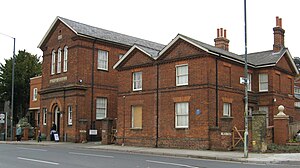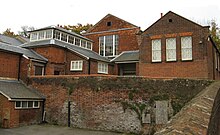
Hitchin is a market town in the North Hertfordshire district of Hertfordshire, England. The town dates from at least the 7th century. It lies in the valley of the River Hiz at the north-eastern end of the Chiltern Hills. It is 16 miles (26 km) north-west of the county town of Hertford, and 35 miles (56 km) north of London. The population at the 2021 census was 35,220.

King Edward's School (KES) is an independent day school for boys in the British public school tradition, located in Edgbaston, Birmingham. Founded by King Edward VI in 1552, it is part of the Foundation of the Schools of King Edward VI. It is a member of the Headmasters' and Headmistresses' Conference.

Joseph Lancaster was an English Quaker and public education innovator. He developed, and propagated on the grounds both of economy and efficacy, a monitorial system of primary education. In the first decades of the 19th century his ideas found application in new schools established in growing industrial centres.
The Monitorial System, also known as Madras System or Lancasterian System/Lancasterism, was an education method that took hold during the early 19th century, because of Spanish, French, and English colonial education that was imposed into the areas of expansion. This method was also known as "mutual instruction" or the "Bell–Lancaster method" after the British educators Andrew Bell and Joseph Lancaster who both independently developed it. The method was based on the abler pupils being used as "helpers" to the teacher, passing on the information they had learned to other students.

The British and Foreign School Society (BFSS) was founded in the early 19th century to support free and non-denominational British Schools in England and Wales. These schools competed with the National schools run by the National Society for Promoting Religious Education, which had the support of the established Church of England, the local parishes, and Oxford and Cambridge universities. Both institutions promoted the monitorial system, whereby few paid teachers supervised the senior students who in turn taught the younger students. After the state assumed responsibility for elementary education in 1870, British schools were transferred to local school boards.

Hitchin Boys' School (HBS) is an 11–18 boys academy-status secondary school, with sixth form, located in Hitchin, Hertfordshire, England. Founded in 1632 by John Mattocke, the single-sex school currently educates around 1,500 boys. The sixth form is part of a consortium for wider teaching with other schools in the town, mixing some classes with pupils from Hitchin Girls' School and The Priory School.

Chesterfield St Helena School, also known as Chesterfield Girls' Grammar School and St Helena School, Chesterfield, was an all-girls high school in Chesterfield, Derbyshire, teaching 11- to 18-year-old girls between 1892 and its closure in 1991. The building now serves as an Area Education Office for Derbyshire County Council.
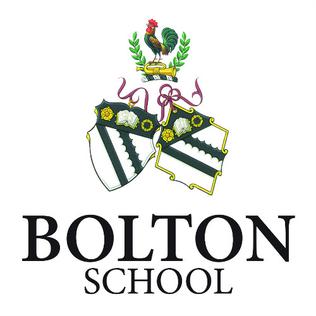
Bolton School is a private day school in Bolton, Greater Manchester. It comprises a co-educational nursery, co-educational infant school, single sex junior schools and single sex senior schools including sixth forms. With over 2,500 pupils, it is one of the largest independent day schools in the country.
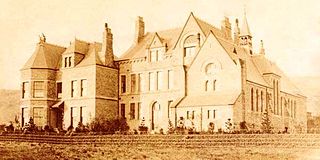
Founded in 1675, Buxton College was a boys' Public School and, from 1923, a grammar school in Buxton, Derbyshire whose site has been expanded since 1990 to be used as the fully co-educational comprehensive Buxton Community School.

Merchant Taylors' Girls' School is a selective private girls' school in Great Crosby, Merseyside, England.

This article gives brief information on schools that cater for pupils up to the age of 11 in the Dacorum district of Hertfordshire, England. Most are county maintained primary schools, sometimes known as "junior mixed infant" (JMI). A small number are voluntary aided church schools or independent (fee-paying). The Local Education Authority is Hertfordshire County Council.

Hyde Park Junior School (HPJS), founded in 1904, is a coeducational junior school located on Hyde Park Road, close to Mutley Plain in Plymouth, Devon, England. Catering for around 360 boys and girls between the ages of 7 and 11, it is housed in the same building as its partner school, Hyde Park Infants. The school's catchment area extends across part of the suburbs of Plymouth including Mutley and Mannamead.
The Kensington Proprietary Grammar School, colloquially referred to as the Kensington School, was an educational establishment founded in 1830 that is perhaps best remembered for being one of the founders of the Football Association in 1863.

St. James's School opened in the Eve Hill area of Dudley in 1842 for pupils aged 5–11. In 1989–1990 it was demolished, then rebuilt at the Black Country Living Museum.

The Priory School is a co-educational secondary school and sixth form located in Hitchin in the English county of Hertfordshire.
St Edward's College, Malta is a Maltese private boys' independent school, with optional boarding, in Cottonera. Its enrollment is just under 700 pupils of 5–18 years of age. It was founded in 1929 by Baroness Strickland, Countess della Catena, who gave a private donation to establish it. It was built on the grounds of what was once a Knights of Malta fort; the rear end of the school is still surrounded by the fort's bastion walls. The school was modelled on the ideas and ideals of British public schools, initially to educate the boys of the Maltese aristocracy and the boys of Malta-based British military officers.
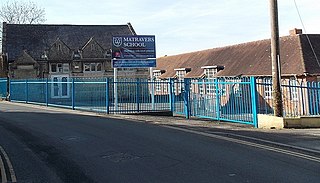
Matravers School is a mixed foundation secondary school and sixth form located in Westbury in the English county of Wiltshire. As a foundation school, Matravers is administered by Wiltshire Council. Pupils are admitted mainly from Bitham Brook Primary School, Bratton Primary School, Chapmanslade CE Primary School, Dilton Marsh CE Junior School, North Bradley CE Primary School, Westbury CE Junior School and Westbury Leigh CE Primary School.

Fortitude Valley State School is a heritage-listed former state school at 95 Brookes Street, Fortitude Valley, City of Brisbane, Queensland, Australia. It was designed by Benjamin Backhouse and built from 1867 to 1913. It is also known as State Emergency Services State Headquarters and former Fortitude Valley Boys School and former Fortitude Valley Girls and Infants School. It was added to the Queensland Heritage Register on 26 March 1999.

Sevington School, near the village of Grittleton, Wiltshire, England, was built in 1848 by Joseph Neeld, a landowner, for the children of his estate workers. It was built in the fashionable Neo-Gothic style and included a schoolroom and teacher’s house with parlour, kitchen and two bedrooms. The curriculum of the private school was narrow and designed to fit pupils for their station in life, either in service or as farm labourers on the Neeld estates. In 1860 Miss Elizabeth Squire was engaged as schoolteacher and she remained in charge until the school closed in 1913. Today it is used as a re-enactment centre for primary school children, and is open to the public during the summer. The building is Grade II* listed by Historic England.

William Wilshere (1754–1824) was an English lawyer and banker. He was an attorney in Hitchin, where he founded a bank in 1789, and a Lancasterian School in 1810.
